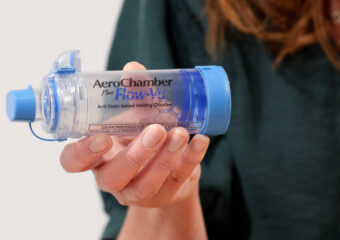Different types of inhalers need to cleaned in different ways.
Your puffer or inhaler will come with instructions in the package. Always check the package insert for any specific instructions.
Instructions for the main types of puffers and inhalers are below. If you aren’t sure which sort of puffer or inhaler you have, ask your pharmacist or check our How-to video library.
A standard puffer consists of a plastic case or holder with a cap, and a metal canister. The plastic case needs to be cared for differently depending on the type of medication you are using the puffer for. The metal canister does not need to be cleaned and should be removed if you are washing the case.
Wash the blue plastic case around once a week. Make sure it’s completely dry before using again.
Puffers for these medications must be washed every day to avoid clogging. Many people who take these medications get two puffers at a time so that they always have a clean and dry one handy.
Wash the white or yellow plastic case every day. Allow it to dry for 24 hours before using again.
These puffers need to stay dry, so must never be washed. The mouthpiece can be wiped with a dry tissue if needed.
Dry powder inhalers include Accuhaler, Breezhaler, Ellipta, Genuair and Turbuhaler.
These inhalers need to stay dry, so must never be washed. The mouthpiece can be wiped with a dry tissue if needed.
The Handihaler capsule dry powder inhaler is an exception. This inhaler needs regular cleaning. Wash the inhaler at least monthly and make sure it’s completely dry before using again.
The only mist inhaler is the Respimat, used for the medications Spiriva and Spiolto.
Wipe the mouthpiece inside and out with a damp cloth once a week. Do not remove the metal cartridge.
Like any medication, out-of-date or unwanted inhalers need to be disposed of carefully.
If the inhaler or canister is empty, it can go in the usual rubbish collection.
If you aren’t sure if the inhaler or canister is empty or if there is still some medication left, return it to your pharmacy for disposal.
You can put the puffer’s plastic case in the household recycling bin.
Return Unwanted Medicines is a national program that provides free and safe disposal of unwanted medicines through local pharmacies.
If you are taking your unwanted inhalers to the pharmacy for disposal, it’s a good opportunity to check the bathroom cabinet for any other old medicines that should be thrown away.
Old medicines lying around the home ‘just in case’ are dangerous…
For more info about pharmacy collection, visit Return Unwanted Medicines Project.

There are many different types, brands and sizes of spacers available. Ask your pharmacist, nurse or asthma educator about which spacer might be best for you or your child.


It's easier to learn how to use your inhaler or puffer when someone shows you how.